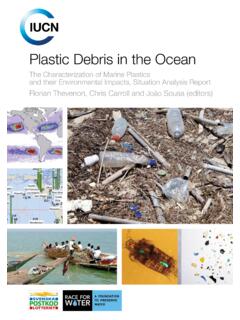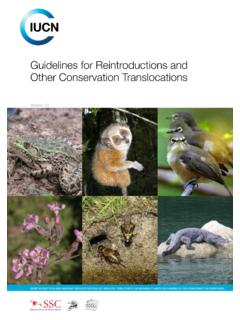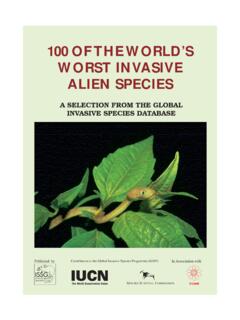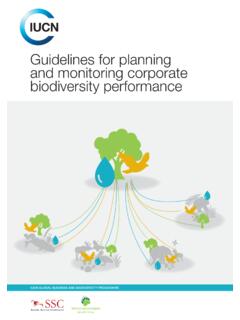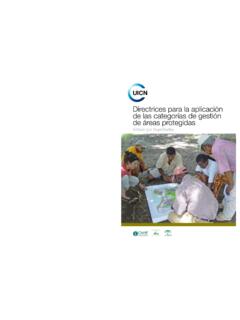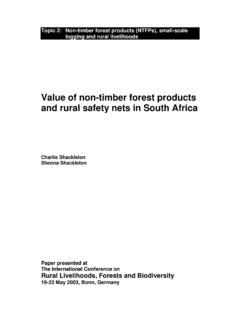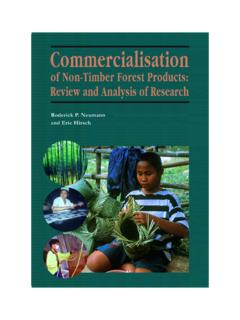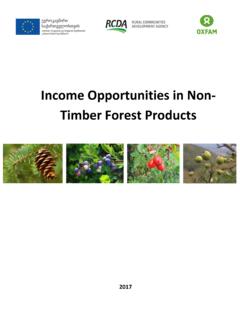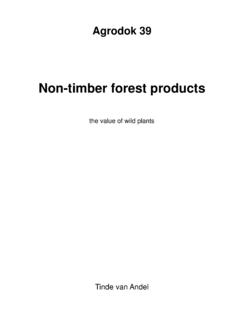Transcription of Non-timber Forest Products - International Union …
1 Non-timber Forest ProductsEcological and economic aspects ofexploitation in Colombia, Ecuador and BoliviaIUCN'S Forest CONSERVATION PROGRAMMEIUCN's Forest Conservation Programme coordinates and supports the activities of the IUCNS ecretariat and members working with Forest ecosystems. The goal of Forest conservation isachieved through promoting protection, restoration and sustainable use of Forest resources,so that forests provide the full potential range of goods and programme makes contributions to policy at various levels and uses field projects to derivelessons to feed into the policy debate.
2 The principles of Caring for the Earth, published jointly byIUCN, WWF and UNEP in 1991, are applied to these projects, which combine the needs ofconservation with those of local communities. One major activity is to develop coherent andinformed policies on Forest conservation in order to advocate the translation of policies intoeffective actions. IUCN frequently advises major development institutions on Forest issues, toensure that conservation priorities are adequately addressed in their projects and Forest Conservation Programme receives generous financial support from the Governmentof the BERNHARD CENTRE FOR INTERNATIONALNATURE CONSERVATIONP rince Bernhard Centre for International Nature Conservation fosters and facilitates strategic andapplied research and training on the conservation and sustainable exploitation of naturalresources and biodiversity.
3 The Centre is interested in conservation and development projectsincluding an implementation component. It works in bilateral or multilateral cooperation withuniversities and NGOs in tropical countries. Follow-up to the study presented in this book has ledto further research and a training programme on sustainable and multiple exploitation of forestproducts in Northern Bolivia. This programme, which involves eight Bolivian and five Dutchscientists, is a result of cooperation between the Universidad Tecnica del Beni, the Institutopara Hombre, Agricultura y Ecologia in Riberalta (Northern Bolivia)
4 , the Government of theNetherlands and the Prince Bernhard NETHERLANDS COMMITTEE FOR IUCNThe Netherlands Committee is an independent foundation uniting the Dutch NGO members ofIUCN, the Dutch members of International IUCN Commissions, and the State as an promotes the implementation of IUCN's objectives within and by the Netherlands, addressingpublic and private sectors alike. Among other things, the Committee carries out programmes onpromoting ecologically sound development cooperation, including involvement in theSustainability Agreements between the Netherlands and Benin, Bhutan and Costa Rica, andlobbying the European Union , the World Bank, the Global Environment Facility and othermultilateral development agencies.
5 Tropical forests have always been a major focus. At present,conservation and social aspects of foreign timber trade are a central issue. The Committeeadministers a fund for small local NGO projects aimed at conserving tropical forests. It has beeninstrumental in putting Non-timber Forest Products on the International Forest agenda with a studyon the economic value of such Products in Southeast Asia in 1989, and pursues the subject inseveral ways. Its involvement in the present study should be seen in that , the Netherlands Committee for IUCN, and Utrecht University are grateful to theGovernment of the Netherlands for the contribution, through the Ministry of DevelopmentCooperation (DGIS)
6 , to the study and to this IUCN Forest Conservation ProgrammeNon- timber Forest ProductsEcological and economic aspects ofexploitation in Colombia, Ecuador and BoliviaGuido BroekhovenIUCN - The World Conservation UnionDepartment of Plant Ecologyand Evolutionary BiologyUniversity of Utrecht1996 Published by:IUCN, Gland, Switzerland, and Cambridge, UK in collaboration withthe Department of Plant Ecology and Evolutionary Biology,University of :Citation:ISBN:Printed by:Cover design:Layout:Cover photo:Available from:(1996) International Union for Conservation of Nature and Natural ResourcesReproduction of this publication for educational or other non-commercialpurposes is authorised without prior written permission from the of this publication for resale or other commercial purposes isprohibited without prior written permission of the copyright , G.
7 (1996). Non-timber Forest Products : Ecological and economicaspects of exploitation in Colombia, Ecuador and , Gland, Switzerland and Cambridge, UK. pp. vi + , Bellegarde-sur-Valserine, FranceJames ButlerPatricia HalladayBaskets from Colombia's Choc region made with palm fibre and natural Publications Services UnitIUCN Communications DivisionRue Mauverney, 28, CH-1196 Gland, presentation of material in this document and the geographical designations employed do notimply expression of any opinion whatsoever on the part of IUCN or of other participatingorganisations concerning the legal status of any country, territory or area.
8 Or concerning thedelimitation of its frontiers or views expressed in this publication do not necessarily reflect those of IUCN or the otherparticipating text of this book is printed on chlorine-free Huntingdon Road, Cambridge CB3 0DL, UK orContentsIntroductionChapter 1 BackgroundExtractive reserves in BrazilChapter 2 Valuing Non-timber Forest productsChapter 3 Non-market valuesChapter 4 Other valuesChapter 5 National economiesChapter 6 Sustainable harvestingChapter 7 Brazil nut and palm heartChapter 8 Conclusions and recommendationsEndnotesReferencesAppendi xContributors139111428356781929697111122 Table 1 Table 2 Table 3 Table 4 Table 5 Table 6 Table 7 Table 8 Table 9 Table 10 Table 11 Table 12aTable 12bTable 13 Table 14aTable 14bTable 15 Table 16 Table 17 Table 18
9 Table 19 Table 20 Table 21 Table 22 Table 23 Table 24 Table 25aTable 25bTable 26 Table 27aTable 27bTable 28 Table 29 Table 30 Table 31 Table 32 Table 33 Indicators of valuePlant speciesNumber of tree speciesMeat consumptionGame meat consumptionProtein needsGame meat consumption: species groupsAgriculture vs. Non-timber productsAnnual production value, Acre, BrazilIncome and NPVE conomic values of Non-timber productsExport from Colombia: 1974-1982 Export from Colombia: 1983-1991 Production for 1990: ColombiaVolume: export of Non-timber Products , EcuadorValue.
10 Export of Non-timber Products , EcuadorExport of Non-timber Forest Products , BoliviaProduction of Non-timber Forest Products , BoliviaMonkeysExport valueExport of parrots and parakeetsCITES-reported exportRegistered exportExports, 1985 Export of parrotsExport of Non-timber Forest Products , PeruNon- timber Forest Products , Peru: 1978-1983 Non-timber Forest Products , Peru: 1984-1989 Export of Non-timber Forest Products , BrazilVolume of Non-timber Forest Products , BrazilValue of Non-timber Forest Products , BrazilExport of Non-timber Forest Products , Brazil: 1985 Export of Non-timber Forest Products , BelizeExport of Non-timber Forest Products , GuatemalaSome Non-timber Forest Products : import of xat from Guatemala and imports, Non-timber Forest Products (average)2324252526262733333334565757585 9606161616263646680112113114115116118120 120120121121121 IntroductionThis report is the result of a studyof the value and the ecologicalimpact of the exploitation of Non-timber Forest Products in Colombia,Ecuador and Bolivia.

